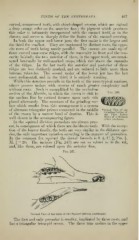Page 457 - My FlipBook
P. 457
TEETH OF THE VERTEBRATA. 467
curved, compressed teeth, with chisel-shaped crowns, which are stained
a deep orange color on the anterior face ; the pigment which produces
this color is intimately incorporated with the enamel itself, as in the
shrews, and serves to sharply define the limits of the enamel covering.
In both the upper and lower jaws the first molar is the largest and
the third the smallest. They are implanted by distinct roots, the oppo-
site rows of teeth being nearly parallel. The crowns are made up of
three curved transverse ridges, with the convexity in front and the con-
cavity beliind ; the two anterior of these, in the upper teeth, are termi-
nated internally by well-marked cusps, which rise above the summits
of the ridges. In tlie last tooth the anterior and posterior of these
ridges are less distinctly marked, and are reduced to little more than
internal tubercles. The second molar of the lower jaw has tlie last
crest rudimental, and in the third it is entirely wanting.
While this structure j^revails in the teeth of tlie more typical murines,
others possess molars with crowns of much greater complexity and
witliout roots. Such is exemplified by the arvicoline
Fig. 246.
section of tlie Muridce, in which the crown is (;left to
the median line by vertical fissures upon each side
placed alternately. The structure of the grinding sur-
face which results from tliis arrangement is a system
of alternate triangular prisms connected in the middle Vertical Mew of the
('.rinding Surface of
of tlie cro^vn by a narro\v btuid of dentine. This is the First Lower
Molar of a Muskrat
well shown in the accompanying figure.
(Fiber zibethicus).
In the S(}uirrel division premolars are always pres-
ent, in consequence of which there are deciduous teeth, With the excep-
tioii of the beaver family, the teeth are very similar in the different spe
cies, the only important variation occurring in the number of premolars.
In the common fox squirrel the dental formula is I.ai rormuia is i. \, C. ^, P m.
=
M. # = 20.20. The
The incisors (Fig. 247) are not so robust as in the rat,
f
and, like them, are colored upon the anterior face.
Fig. 247.
Vertical View of the Teeth of Fox Squirrel {Sciurus carolinensis).
The first and onlv premolar is smaller, implanted by three roots, and
has a triangular tricuspid crown. The three true molars in the upper


